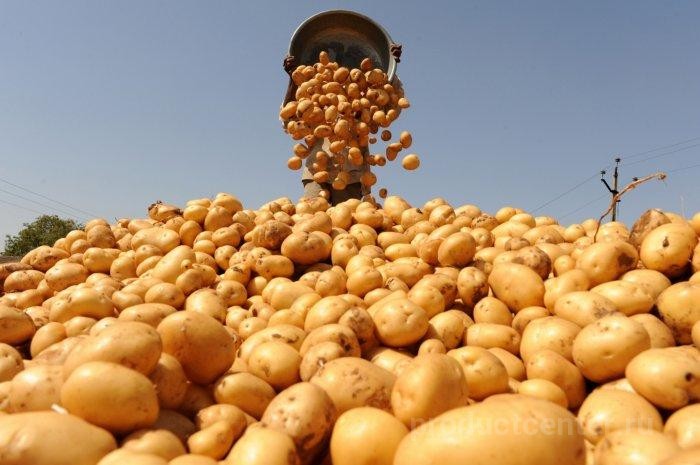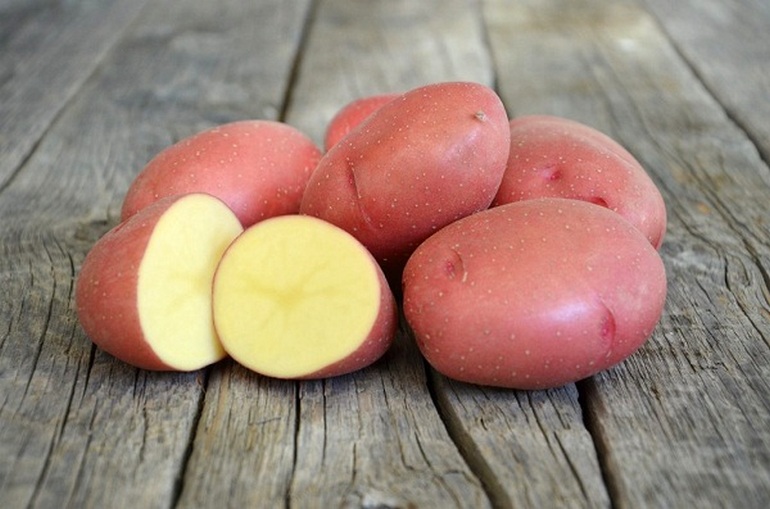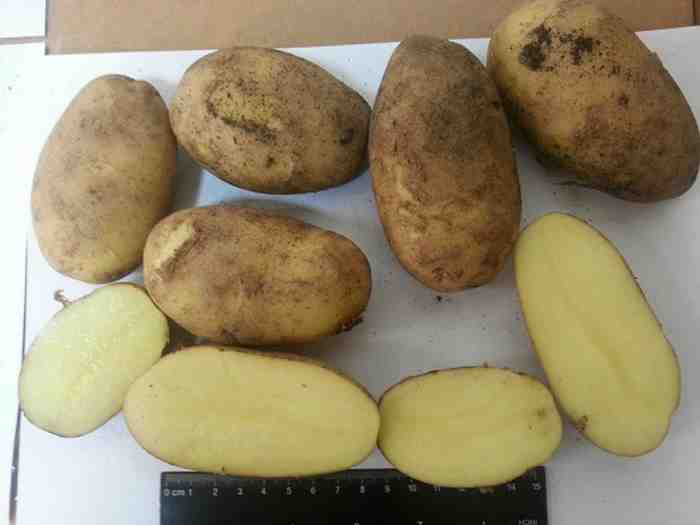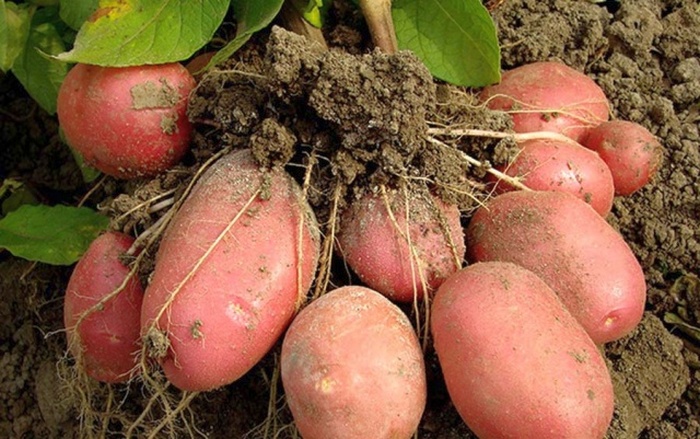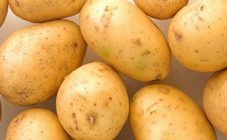Content:
Before proceeding to the description, one should understand the very definition of the Elite potato, what kind of variety it is, and what it is. In fact, "Elita" is not a variety, but a collective name for dozens of different varieties of the elite group, artificially bred on the basis of potatoes, which have the best indicators of adaptation to unfavorable growing conditions, cold resistance, yield, rarely susceptible to diseases. From each of them, only positive qualities were taken to breed a universal culture that could withstand the influence of difficult climatic conditions, common diseases and hordes of pests. At the same time, such potatoes should yield bountiful harvests on the most impoverished soils, withstand drought and be satisfied with minimal maintenance. The elitism of a particular variety is expressed in the totality of these characteristics, and not in the high cost and beautiful appearance of root crops that claim a high rank.
A brief excursion into history
Many mistakenly classify Elite potatoes as genetically modified forms, the effect of which on the human body has not yet been fully studied, but even what is known about them clearly speaks against such products. Elite potato varieties have little to do with this. GMOs are the result of crossing various cultures and living organisms, endowing plants with qualities that are completely inherent in them.
Elite varietal potatoes are born in the laboratory, but they are derived exclusively from other, related varieties of root crops. It is interesting that the beginning of selector activity was laid by the ancient Incas, 1000 years before the discovery of America and the acquaintance of Europeans with this amazing vegetable. The first who became interested in the creation of elite varieties was the Soviet academician N. Vavilov, who brought wild specimens from Peru in 1924. The first known elite variety was "Lorkh", which has not been surpassed in yield for almost 100 years of existence, in this its indicators are striking - more than a ton of potatoes from 1 are.
Characteristics of elite varieties popular in Russia
It is not possible to describe all existing elite potato varieties in one story, or at least compare with each other, for the reason that this will require a hundred separate articles. All of them are radically different in a number of characteristics: the color and shape of the roots, the appearance of the bush, the flowering time and ripening period, yield, resistance to cold, drought, disease, and have their own characteristics.
Attention should be paid to those applicable for planting in Russia, popular among ordinary gardeners and professional farmers. Russian potato variety Elita includes a description of the following characteristics and features.
Characteristics of elite potato varieties
| Variety name | Lina | Lyubava | Tuleyevsky |
|---|---|---|---|
| Main characteristics | The potatoes are large, weighing more than 100 grams, on average from 110 to 250 grams. The shape is oval, the skin is smooth, light yellow in color, with a few shallow eyes. Inside are white, the starch content is above average, at 11.5-18.5%. | Large potatoes, over 100 gr. by weight, on average from 110 to 210 grams. The shape is oval-rounded, elongated, the skin is smooth, bright red, with a small number of medium-sized peepholes. The pulp is white inside, the average starch content is in the range of 11.5-17%. | Root vegetables are large, much more than 100 grams, the average weight of each is from 120 to 270 grams. The shape is oval, elongated, the skin is mesh, with roughness, beige-yellow in color, with sparse eyes, almost without depressions. The core is creamy, the starch content is 11-16.5%. |
| Frost resistance | Resistant to sharp fluctuations and drops in temperature indicators. Easily withstands frosts on the ground down to -80. Seedlings do not disappear during frostbite, but they can hurt. Included in the State Register applicable to the West Siberian region. | High indicators of frost resistance and adaptation to difficult climatic conditions. It tolerates spring frosts on the ground from -5 to 80. With severe freezing, it can be damaged, it starts to hurt, but rarely disappears. Designed for growing in the West Siberian region. | It belongs to frost-resistant varieties, but it does not tolerate too low temperatures. Withstands night frosts from 0 to -50. With frostbite, it rarely disappears, but growth after that slows down. Included in the State Register for the Middle Volga region. |
| Early maturity | A mid-early variety, the growing season lasts from 70 to 80 days from the moment the first shoots appear or 105-110 days from the moment of planting. Early potatoes appear in the period 50-55 / 85-90 days, respectively. Cleaning takes place from late August to mid September. | Belongs to early maturing varieties, ripening occurs within 60 to 70 days from the moment of germination or 80-90 days from the moment of planting. Early fruits ripen in the first half of July, in the period 38-45 / 65-70 days. Potatoes are harvested from mid-August to early September. | A variety of mid-season varieties with a growing season of 65 to 75 days after the first shoots appear or 100-110 days after planting. The first harvest of young root crops is carried out in the period 48-55 / 80-85 days. Harvesting lasts from early to mid-September. |
| Yield | The harvest volumes of this variety largely depend on weather conditions and many related factors. It is classified as a medium-yielding one, although a lot of potatoes are harvested. On average, this is 25-50 kg from 10 m2, the maximum is up to 55 kg. On an industrial scale - 233-490 centners per hectare. | Approximately the same indicators as in the previous variety. But the yield of Lyubava is more stable and less dependent on weather and other conditions. The level of its yield is above average, from 10 m2 on average it is harvested from 30 to 48 and up to a maximum of 52 kg. Industrial cultivation brings a maximum of 520 kg / ha. | A high yield characteristic of this elite seed potato. The tuber weight of one bush reaches 7-7.5 kg, which allows harvesting from 10 m2 in the range of 300-350 kg. Growing on an industrial scale brings simply amazing results - from 40 to 50 tons per hectare. |
| Disease resistance | Refers to medium resistant. The culture is most resistant to potato crayfish and all varieties of late blight (pathogens had race-specific infections). Poorly tolerates golden nematode. | Medium resistant to major diseases, which is very similar to Lana. Rarely susceptible to potato cancer and late blight. Has a high susceptibility to cyst nematodes. | High resistance to most potato diseases, including viral ones. Resistant to Alternaria, rot, cancerous lesions, common and silver scab. Like the previous varieties, it does not tolerate the manifestation of a nematode. |
| Plant parameters | The bushes of the culture are quite tall, not too dense, erect. The stems are powerful, with few branches. Leaves are medium in size, rounded in shape, dark green in color, almost devoid of hairiness. | The bush is medium in height, compact, upright, of an intermediate type. Stems are dense and not too thick, branched.The leaves are small and rather thick, rounded, with slight waviness of the edges, juicy green, slightly fleecy. | The bush is not tall, but dense, spreading, with a lot of thick shoots. Stems are square, rather branched. Leaves are medium in size, slightly elongated, open type, devoid of waviness. The color is deep dark green, with sparse, light streaks. |
| Flowering period | The usual flowering period is early July and lasts until mid-month. Has a dense and compact corolla with large white inflorescences and a yellow center. High intensity flowering, producing a large number of berries. | During flowering (from late June to mid-July), it emits a small but compact corolla, with inflorescences of medium size and density. Colors range from blood red to purple-violet. The flowering intensity is low, with rare berry formation. | Blooms in late June - early July. It has a large white corolla, with many large purple inflorescences with a bright yellow center. Flowering of medium intensity, berries are rarely formed. |
The peculiarity of growing elite varieties
In terms of agrotechnical characteristics, most varieties differ little, there are minor differences in the timing of planting, leaving, but in general, in this part of the description, all of them can be combined into one group. Self-breeding of seed potatoes is not an easy and too long process, it takes from 3 to 5 years, you cannot do without the necessary knowledge, and therefore it is more relevant to acquire it. The primary task is to decide on the choice of a particular variety, weighing all the pros and cons, with a place where you can buy potatoes for planting without risk, taking into account its required amount. Depending on the cultivated area, it is purchased wholesale or retail.
The whole sequence of actions from purchase to harvesting the first harvest is as follows:
- First of all, before planting in the ground, the planting material requires preparation, which consists in germination - the process is simple, but responsible. Its purpose is to get multiple shoots, thick, 5-8 mm long - it is no longer desirable, they will break off when planting, this does not contribute to productive cultivation. To keep the loss of shoots to a minimum, you should put the roots in shallow boxes and place them in a bright, well-heated place for 3 to 4 weeks. You do not need to shift them, transport them as they are, you can plant them directly from the boxes;
- No less attention should be paid to the selection and preparation of the site where the Elite seed potatoes will be cultivated. It is better to take care of this in advance, ideally in the fall, although most of these varieties are not demanding on the composition of the soil. But a caring attitude will not harm them, especially since cultivation pursues the goals of breeding to ensure a full-fledged planting for the next year. The soil should be enriched with mineral fertilizers applied in September-October, river sand, peat, compost or birch ash, just before planting;
- The requirements for the prepared site are simple: it must be plowed or dug up in the fall to a depth of 22-25 cm, cultivated in the spring, as soon as the snow melts, and the soil dries up, clouded up in order to retain moisture in it. It is necessary to remove all weeds, it is better not by weeding, but to pull them out by the roots and throw them away from the site.Regardless of the degree of frost resistance and cold resistance, planting is carried out only when the soil warms up to at least + 9-110, this is determined by fumes emanating from the ground, distorting the picture of the surrounding landscape - the best evidence of a suitable time for planting;
- Before planting potatoes in the ground, it will be necessary to process it with a set of special means: to stimulate growth, protect against pests and possible diseases inherent in the culture as a whole, since this is not the strongest side of elite varieties. Such measures will bring many benefits to grown root crops and save gardeners from the need to process green mass in the future in the fight against the Colorado potato beetle and other pests, which is much more troublesome. Preparations for these purposes are selected individually;
- It is not worth planting elite potatoes to a great depth, a maximum of 12 or an average of 8-10 cm, so that the layer of soil covering the roots is at a level of 6-8 cm.At great depths, by May, when planting most often occurs, the ground is still slightly warmed up and does not reach the required temperature, but too damp - this will slow down growth. The distance between each of the pits or grooves is maintained within 40 cm, which is necessary for the growth of tubers in breadth, at the time when they are formed. An indispensable condition - each bush should receive as much sunlight and heat as possible;
- Most of the elite varieties are not demanding in care, rarely need feeding and watering, even in dry periods. The need for irrigation arises only when the crop is flowering - this is the most crucial moment when most of the procedures are carried out, the main of which is hilling 2-3 times during the season. Such a measure is aimed at saturating the soil with oxygen - the only thing that potatoes really need, and protecting it from the influence of ultraviolet radiation. In parallel with this, it is necessary to ensure that both the tubers and the green mass remain healthy, are not attacked by pests that can destroy the entire crop.
Advantages and disadvantages
Statistics are stubborn things, they say: despite all the attempts to bring out the ideal variety, this still does not exist. The logic behind this is simple: if an ideal variety existed, it would be grown by everyone, and others would simply be forgotten. All names of elite potatoes have their positive and, at the same time, not the greatest strengths. If we take 3 Russian elite varieties as a basis, we get something like this:
- high rates of tolerance to difficult weather conditions;
- most of these varieties are early and mid-season;
- the highest yields that are inaccessible to conventional varieties;
- high levels of starch and nutrients;
- predominantly excellent taste;
- unpretentiousness and undemanding care.
As for the disadvantages, they are as follows:
- not the highest resistance to certain diseases;
- short storage times, which require special conditions;
- lack of resistance to mechanical damage.
Opinions about the viability of cultivating elite varieties were divided approximately equally. On the one hand, rarely any of the usual is able to surpass them in yield and endurance in difficult climatic conditions. On the other hand, it is extremely difficult to keep them, and this is important - one wrong or careless action can negate the fruits of all work.
